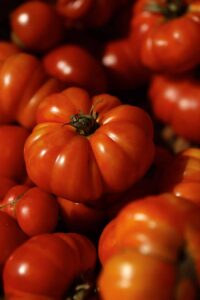Who hasn’t admired a plate full of knobby, multicolored heirloom tomatoes In recent years, heirlooms have taken the culinary world by storm.
Top chefs pay a fortune for heirlooms, both for their superior flavor and their beauty. Dark purple, rich green, zesty yellow heirloom tomatoes brighten the plate and attract attention.
What’s Heirloom Tomato ?

An heirloom tomato is an open-pollinated heirloom cultivar of tomato. According to tomato experts, heirloom tomatoes can be classified into four categories: family heirlooms, commercial heirlooms, mystery heirlooms, and created heirlooms. ( source )
Better yet, they dramatically expand the universe of possible tomato flavors.
Tomato fanatics swear there is nothing that can beat a well-grown heirloom tomato. They have the most complex flavor, and the most satisfying bite.
They can be sweet, almost like syrup, or they can be dusky and even a tad spicy.
Some restaurants and farmer’s markets even offer tomato sampling trays, where you can try all different kinds and flavors of heirlooms.
What makes an heirloom tomato an heirloom is a little more fuzzy ?
What makes an heirloom tomato an heirloom is a little more fuzzy. Not so long ago, all tomatoes were basically heirloom, mostly because there was no large-scale commercial tomato breeding.
But this began to change in the decades after World War II, when the agricultural industry organized and matured. Commercial seed breeding companies moved heavily into tomato programs. They wanted to create the perfect tomato for the market.
And their vision of a perfect tomato was pretty straightforward: large, red, disease-resistant and thick-skinned. These tomatoes could be field-grown in huge quantities, picked early, and force-ripened with ethylene gas.
They could be packed into crates and shipped across the country and not spoil, split or get smooshed. In other words, they created the beast we know as grocery store tomatoes.x By the 1970s, these hybrid tomatoes had taken over commercial tomato farming in a sea of uniformly red fruit.
The Commercial hybrids were disease-resistant
Yet the advent of hybrids wasn’t all bad. The same qualities that turned on commercial farmers were great for home growers. Commercial hybrids were disease-resistant.
They set fruit in hot weather and in arid climates. Basically, they made it easier than ever to grow your own tomatoes.
How many heirloom ninjas today started with sturdy hybrids ?
Good question! they might never admit it! In reality, lots of very experienced growers (myself included) still grow hybrid tomatoes. They perform beautifully, they yield well, and they’re fun to grow.
But when it comes to sheer tomato glory when it comes to elevation from tomato grower to tomato ninja the world of heirlooms is always waiting with a bewildering variety of shapes, flavors and hues. It’s a misconception that all heirlooms are hard to grow. They aren’t.
Some are perfectly vigorous with a natural disease resistance and have huge yields. Others well, yeah, they’re earned their reputation as finicky. Perhaps none so much as the various Brandywine heirlooms.
Many people consider the Sudduth Brandywine to be the king of beefsteak tomatoes. They are large, gorgeous, pink tomatoes with incredible flavor. When you bite into a Brandywine, you think, So this is what a tomato should taste like! It’s a delight.
But they are also notoriously finicky, and their yields are wildly variable. Some years, the Brandywine will produce like mad. In others, you’ll be happy to harvest one or two tomatoes from each plant.
History of Heirloom Tomato
Pinning down an exact definition for what makes an heirloom can be tricky. Most heirlooms have been passed down in families or communities, until they were discovered by the tomato community and preserved.
The Seed Savers Exchange, a nonprofit organization created in 1975 in Iowa, has dedicated itself to preserving America’s heirloom and heritage vegetable varieties. Similar seed exchanges operate throughout the tomato-growing world.
Lately, commercial seed companies have also dramatically expanded their offerings of heirloom seeds so it can be a bit confusing where the line between hybrid and heirloom cuts off (especially considering that all heirlooms are the product of hybridizing, just usually on a much smaller scale).
Some people say a variety has to be at least 50 years old to be an heirloom. Others say it merely has to be the offspring of two established heirlooms.
Heirloom Tomato and Pollination
One good hint you’re dealing with a traditional heirloom is whether the tomato is open-pollinated or not. Open pollinated tomatoes produce viable seed that can be saved and used year after year.
By contrast, modern hybrids produce seed, but the seed is not stable. It may not germinate at all (so it’s sterile), or the offspring might lose the desirable characteristics of the parent plant.
This is the trade-off seed companies make to get tomatoes with certain desirable qualities, and since tomato seed is cheap, it’s not usually a big deal for most growers to buy new seed every year.
Open-pollinated tomatoes, on the other hand, are genetically stable. Seed from a parent plant will yield the same plants in successive generations. You’ll never have to buy replacement seed.
So it’s actually fair to say that the heirloom renaissance is really a renaissance of open-pollinated tomato plants.
And this is a good thing as more and more people discover open-pollinated plants, Tomato and expands and valuable genetic lines are fortified and preserved.
It’s like a history project on a plate, the farming heritage of a land as read through the plants that people love, grow and eat.
